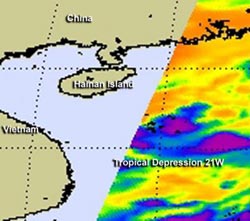NASA observes another tropical depression birth in northwestern Pacific

Infrared imagery from the AIRS instrument aboard NASA's Aqua satellite captured this image of Tropical Depression 21W as a developing low pressure area on Sept. 30. The purple areas indicate the most powerful thunderstorms with coldest cloud top temperatures.<br><br>Credit: NASA/JPL, Ed Olsen<br>
On Monday, Oct. 1 at 1500 UTC (11 a.m. EDT), Tropical Depression 21W (TD21W) had maximum sustained winds near 25 knots. It was centered about300 nautical miles south of Hong Kong, near 17.4 North latitude and 114.8 East longitude. TD21W has tracked northward at 5 knots and is expected to curve to the northwest and west.
On Oct. 1, 2012, infrared imagery from the Atmospheric Infrared Sounder (AIRS) instrument aboard NASA's Aqua satellite shows that the center of circulation is well-defined and the strongest thunderstorms are building in the southeastern quadrant of the storm and wrapping into the center.
The system has been quasi-stationary over the past 12 hours, because it is in a weak steering environment with nothing to push the storm in any direction.
Forecasters at the Joint Typhoon Warning Center expect that Tropical Depression 21W will start moving to the west and approach the central Vietnam coast by Oct. 6 or Oct. 7.
Media Contact
More Information:
http://www.nasa.govAll latest news from the category: Earth Sciences
Earth Sciences (also referred to as Geosciences), which deals with basic issues surrounding our planet, plays a vital role in the area of energy and raw materials supply.
Earth Sciences comprises subjects such as geology, geography, geological informatics, paleontology, mineralogy, petrography, crystallography, geophysics, geodesy, glaciology, cartography, photogrammetry, meteorology and seismology, early-warning systems, earthquake research and polar research.
Newest articles

Superradiant atoms could push the boundaries of how precisely time can be measured
Superradiant atoms can help us measure time more precisely than ever. In a new study, researchers from the University of Copenhagen present a new method for measuring the time interval,…

Ion thermoelectric conversion devices for near room temperature
The electrode sheet of the thermoelectric device consists of ionic hydrogel, which is sandwiched between the electrodes to form, and the Prussian blue on the electrode undergoes a redox reaction…

Zap Energy achieves 37-million-degree temperatures in a compact device
New publication reports record electron temperatures for a small-scale, sheared-flow-stabilized Z-pinch fusion device. In the nine decades since humans first produced fusion reactions, only a few fusion technologies have demonstrated…





















